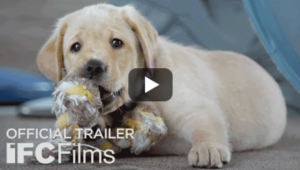Just got back last night from Champaign-Urbana, Illinois — Mike drove Whitney and me down there so I could give a presentation to a lecture hall of 400+undergraduates enrolled in an Animal Sciences class at the University of Illinois.
Inspired by the Pick of the Litter documentary Mike posted about on Monday, I spent a fair amount of my talk going over some of the qualifications necessary to become a guide dog instructor.
I mean, Pick of the Litter does a tremendous job explaining how schools decide which puppies pass the audition to go on to train as guide dogs, but what about the audition to become a guide dog trainer?
Most guide dog schools require instructors to have a college degree and then do an apprenticeship, and apprenticeships can last as long as four years – there’s a lot of learning involved when it comes to training dogs, training people who can’t see, and then making a perfect match between the human and canine.
Once apprentices finish their training and become full-time Seeing Eye Instructors, they’re assigned a string (a group) of dogs and given four months to train that string. Throughout the training, instructors pay close attention to each dog’s pace and pull, and they make careful notes about how each dog deals with distractions, what their energy level is, and all sorts of other characteristics. And then? We blind students fly in from all over North America to be matched — and trained — with a new dog.
Seeing Eye instructors have to be as good at evaluating people as they are evaluating dogs. Our instructors review our applications before we arrive on the campus in Morristown and then ask us tons more questions when we get there. Instructors take us on “Juno” walks (they hold the front of the harness to guide us through all sorts of scenarios to get an idea of how fast we like to walk and how strong of a pull we’ll want from our dog). After that, instructors combine all of this information with what they know about their string of dogs, talk it over with fellow instructors and the team supervisor, mix in a little bit of gut instinct, and voila! A match is formed.
Each Seeing Eye instructor trains more dogs than they’ll need for a class. If a dog has a pace, pull, or energy level that doesn’t match with a blind person in the current class, that dog remains on campus with daily walks and care, and perhaps more training, until the next class arrives.
In my talk yesterday, I described each of the four dogs I‘ve been matched with over the past 27 years. My first dog, Dora, was one of those Seeing Eye dogs who went through a second round of training before she was matched with me. Back in 1991, the Seeing Eye knew that the dog they matched me with would be landing in the home of a very unique five-year-old boy named Gus, and that the dog would be in the hands of a woman who had never had a dog before. They must have figured Pandora would need all the extra training she could get!
After Dora came Hanni, the star of my children’s book Safe & Sound, and then Harper, my hero.
And now? Whitney. This Golden/Labrador Retriever cross Whitney is a hard worker who loves to play as much as she loves to work. Her curiosity gets the better of her at times, but she’s just smart enough to try bending the rules without getting in trouble. Sound like a human being you know?!
“Seeing Eye instructors must have known Whitney and I would make a good match,” I said with a shrug to the college kids yesterday. “We see eye to eye.”

Thought of you and Whitney (and Harper and Hanni) last week when we stopped overnight in Nashville on a longer road trip–sign on the same block as our hotel touted the founding of The Seeing Eye! The website says the organization was incorporated there in 1929 and moved to New Jersey two years later “because the climate in the northeast was more suitable for training dogs.” More snow to learn to deal with? Less heat? Glad you have gotten so many great partners from the organization.
Takes a special breed to raise/train/place one of these picks of the litter. Mind boggling to consider what their efforts matched with one of these special little guys provides.
Hi Beth,
I’m sure you wowed them or should I say bow wowed them with your experiences with the
dogs you have had. I hope some of those students try and train some do pups. Unfortunately, those students didn’t have questions for you like the third graders you had where one asked you if your dog could read braille. That was hilarious!! Keep up the good work and have happy holidays.
Yes, she sounds like a human being I know called Beth. You are a perfect match!
Amazing! But of course, creating the almost ‘perfect’ dog to keep you safe must also take special people.
Thank you all for these thoughtful, positive comments. And Annelore, you are so right: the human beings involved are the pick of the litter, too!
Leave a Response